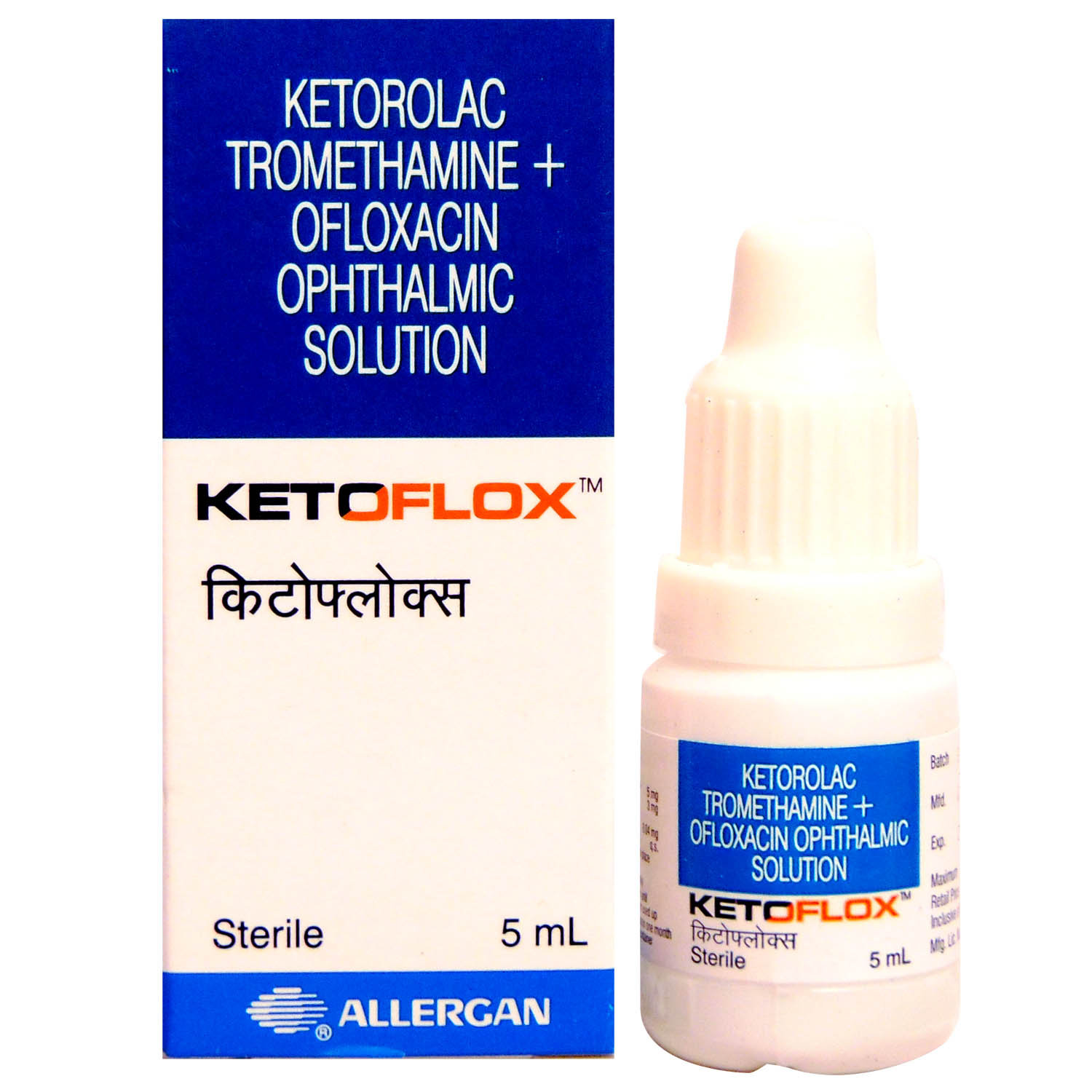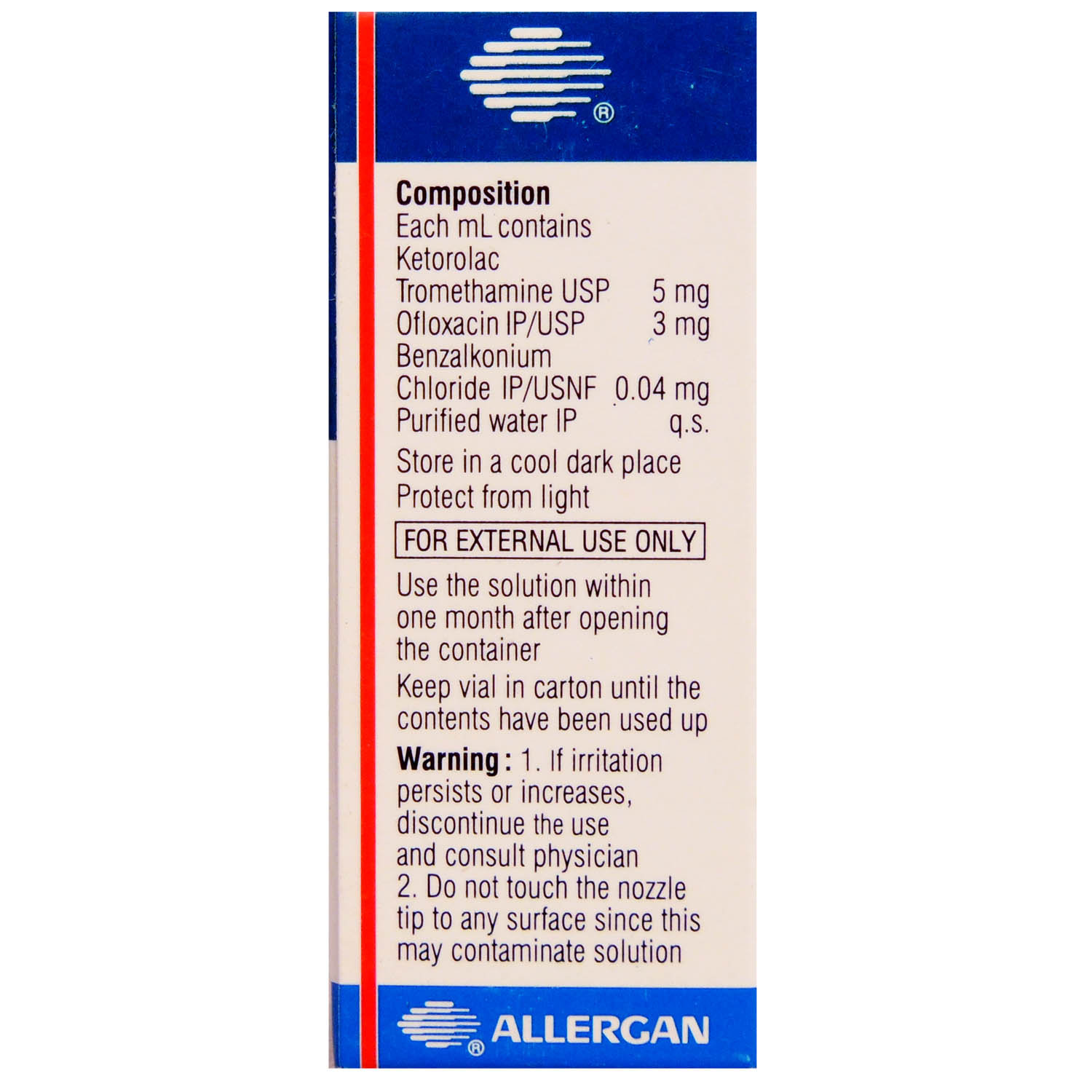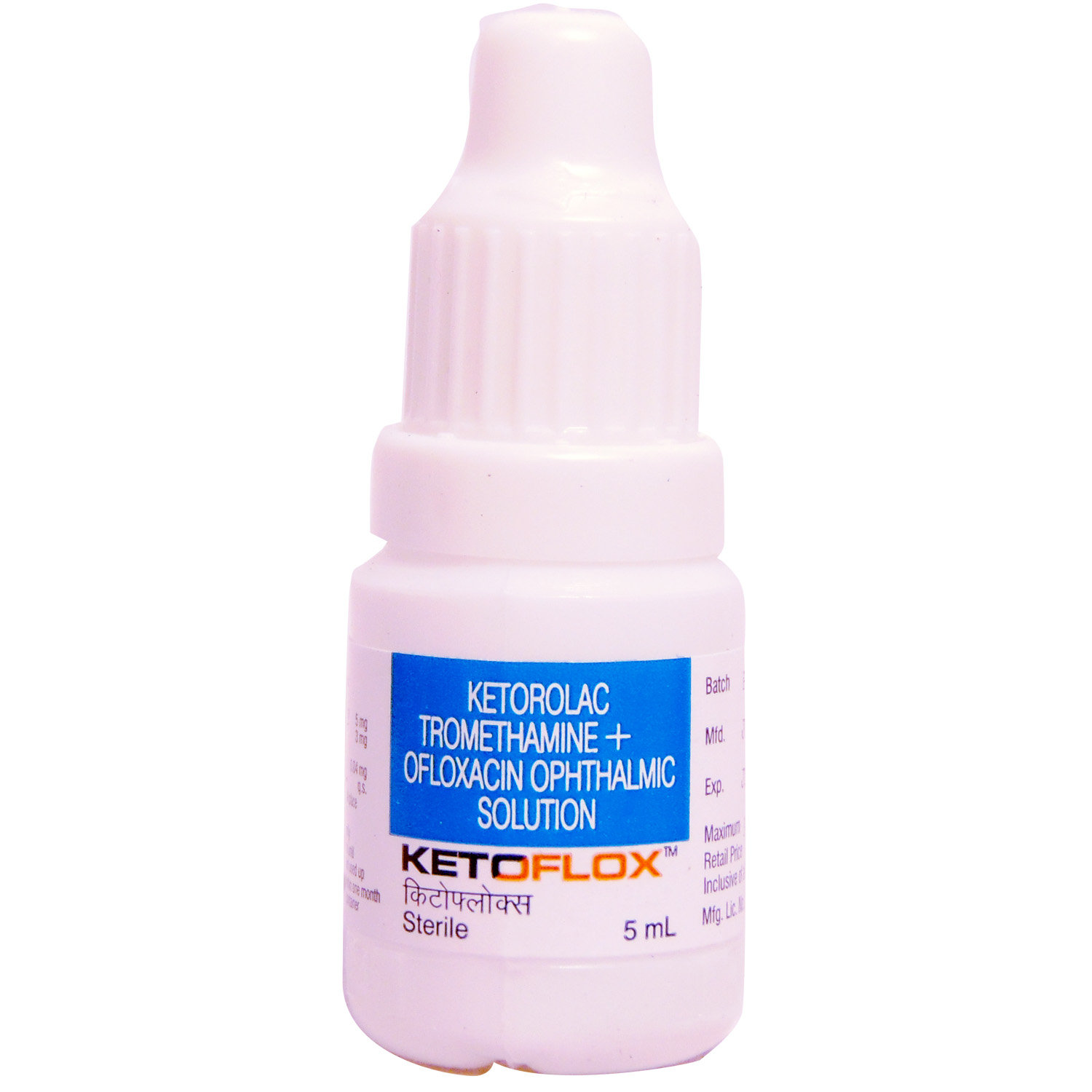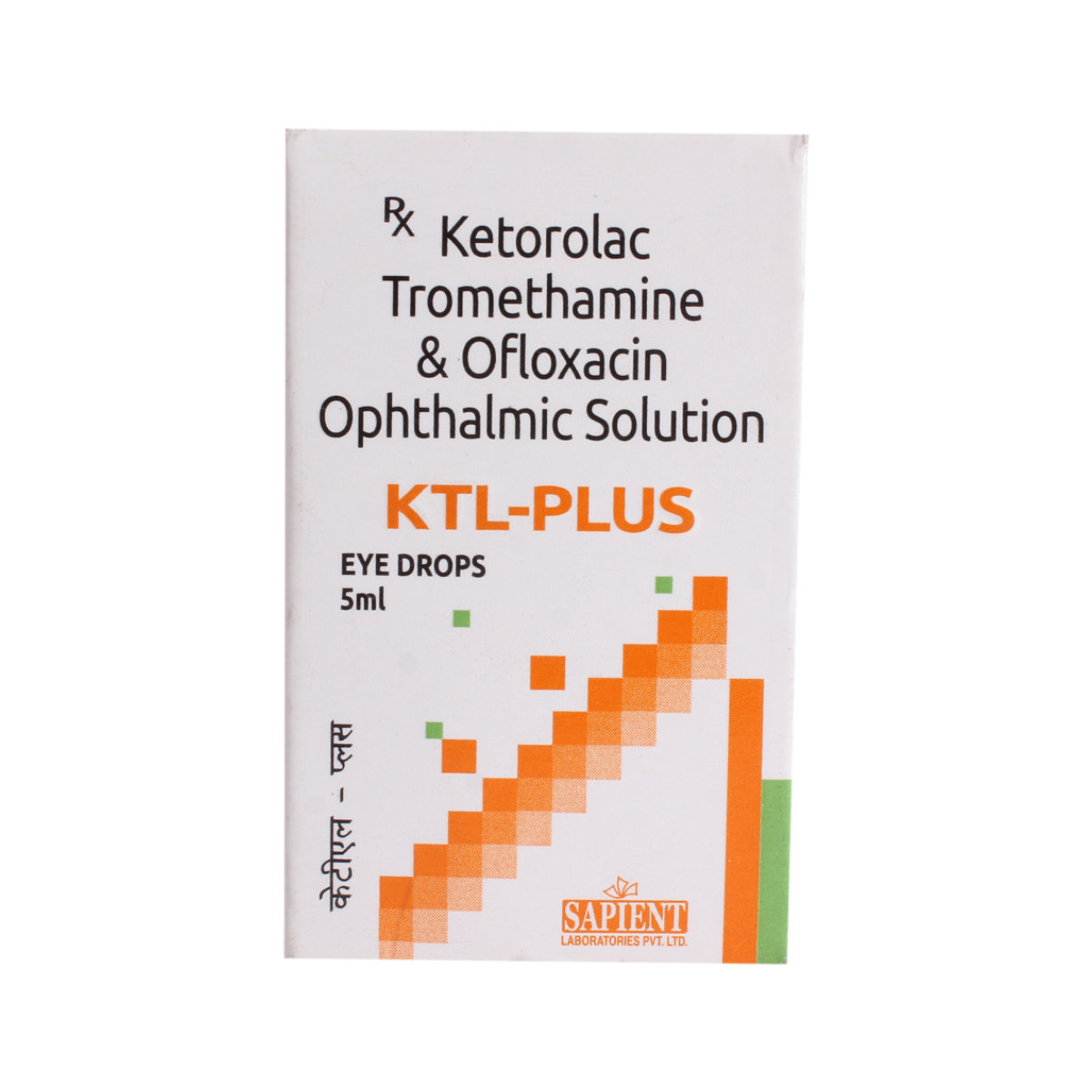Ketoflox Opthalmic Solution 5 ml



MRP ₹154.5
(Inclusive of all Taxes)
₹23.2 Cashback (15%)
know your delivery time
Provide Delivery Location
Composition :
Manufacturer/Marketer :
Consume Type :
Expires on or after :
Return Policy :

Secure Payment

Trusted by 8 Crore Indians

Genuine Products
Therapeutic Class
Country of origin
Manufacturer/Marketer address
Disclaimer
Alcohol
Safe if prescribed
Ketoflox Opthalmic Solution 5 ml may not interact with alcohol.
Pregnancy
Consult your doctor
Ketoflox Opthalmic Solution 5 ml should be used with caution in pregnant women as it is not known whether Ketoflox Opthalmic Solution 5 ml could harm an unborn baby.
Breast Feeding
Consult your doctor
Ketoflox Opthalmic Solution 5 ml should be used with caution in breastfeeding women as it is not known whether Ketoflox Opthalmic Solution 5 ml could harm a nursing baby.
Driving
Safe if prescribed
Ketoflox Opthalmic Solution 5 ml may cause temporary blurred vision, so do not drive or operate heavy machinery until your vision is clear.
Liver
Consult your doctor
Ketoflox Opthalmic Solution 5 ml is probably safe when used in patients with liver diseases.
Kidney
Consult your doctor
Ketoflox Opthalmic Solution 5 ml is probably safe when used in patients with kidney diseases.
Children
Safe if prescribed
Ketoflox Opthalmic Solution 5 ml is not recommended for children below 2 years of age. For children above 2 years, the dose may have to be adjusted by your doctor.
Product Substitutes
About Ketoflox Opthalmic Solution 5 ml
Ketoflox Opthalmic Solution 5 ml belongs to the class of ocular medications called ‘Ophthalmic agents’ used to treat bacterial eye infections or eye discomfort, especially in patients who have undergone eye surgeries. It used to treat eye infections such as conjunctivitis (inflammation of the conjunctiva) and inflammatory conditions of the other parts of the eye (cornea, iris, and connective tissue).
Ketoflox Opthalmic Solution 5 ml is a combination of two medicines: Ofloxacin and Ketorolac. Ofloxacin is a fluoroquinolone antibiotic that interferes with the formation of essential proteins required for bacterial growth. Ketorolac is a nonsteroidal anti-inflammatory drug. It works by reducing the production of chemical substances that cause pain and inflammation in the eye.
Ketoflox Opthalmic Solution 5 ml is available for ophthalmic (for eye) use only. You should use this medicine as prescribed by your doctor. The common side-effects of Ketoflox Opthalmic Solution 5 ml are eye pain, redness, burning or stinging sensation and watery eyes. Eye drops may also cause temporary blurred vision. If any of these side-effects persist, consult your doctor immediately.
It is not recommended to take Ketoflox Opthalmic Solution 5 ml if you are allergic to any contents of it or other fluoroquinolone antibiotics such as levofloxacin, ciprofloxacin and moxifloxacin, etc., or any NSAIDs such as ibuprofen, diclofenac or indomethacin, etc. Ketoflox Opthalmic Solution 5 ml should be used with caution in patients with diabetes, arthritis, bleeding or blood clotting disorder, glaucoma (increased pressure inside the eye) and dry eye syndrome (condition of having dry eyes). It should be used with caution in pregnant and breastfeeding women. It is not recommended for use in children below two years. Ketoflox Opthalmic Solution 5 ml should be used with caution in elderly people. Ketoflox Opthalmic Solution 5 ml may not interact with alcohol. Ketoflox Opthalmic Solution 5 ml may cause temporary vision problems, so do not drive or operate machinery until your vision is clear.
Uses of Ketoflox Opthalmic Solution 5 ml
Medicinal Benefits Mweb
Key Benefits
Ketoflox Opthalmic Solution 5 ml contains Ofloxacin (antibiotic) and Ketorolac (NSAID). Ofloxacin is a broad-spectrum antibiotic and effective against many common infections causing bacterial pathogens. It is active against both gram-positive and gram-negative bacteria. Ketorolac can effectively treat ocular allergy and control inflammation in postoperative patients. Together, Ketoflox Opthalmic Solution 5 ml can effectively treat bacterial eye infections.
Directions for Use
Side Effects of Ketoflox Opthalmic Solution 5 ml
- Eye pain
- Redness
- Burning or stinging sensation
- Watery eyes
Drug Warnings
Ketoflox Opthalmic Solution 5 ml is only for ophthalmic use, and it should be used only in the affected eye. Please do not use it in the ear. Before using Ketoflox Opthalmic Solution 5 ml, inform your doctor if you have diabetes, arthritis (joint pain), bleeding or blood clotting disorder, glaucoma (increased pressure inside the eye) and dry eye syndrome (condition of having dry eyes). Do not wear contact lenses while using Ketoflox Opthalmic Solution 5 ml. Please do not use it more or less often than intended by the doctor. It is recommended to complete the course of therapy even if you feel better. This is because your symptoms usually begin to improve even before the infection is completely cured.
Drug-Drug Interactions
Drug-Drug Interactions
Login/Sign Up
Using Mesoridazine together with Ketoflox Opthalmic Solution 5 ml can increase the risk of an irregular heart rhythm that may be serious.
How to manage the interaction:
Taking Mesoridazine with Ketoflox Opthalmic Solution 5 ml is not recommended, please consult your doctor before taking it. You should seek immediate medical attention if you develop sudden dizziness, lightheadedness, fainting, shortness of breath, or heart palpitations. Do not stop using any medications without talking to a doctor.
Coadministration of Ketoflox Opthalmic Solution 5 ml with Quinidine can increase the risk or severity of irregular heart rhythms.
How to manage the interaction:
Taking Ketoflox Opthalmic Solution 5 ml with Quinidine together is generally avoided as it can result in an interaction, it can be taken if your doctor has advised it. However, if you experience sudden dizziness, lightheadedness, fainting, shortness of breath, chest pain or tightness, rapid heartbeat, or memory loss, contact a doctor immediately. Do not discontinue any medications without consulting a doctor.
Coadministration of Ketoflox Opthalmic Solution 5 ml with Pimozide can increase the risk or severity of irregular heart rhythms.
How to manage the interaction:
Taking Ketoflox Opthalmic Solution 5 ml with Pimozide together can result in an interaction, it can be taken if your doctor has advised it. However, if you experience sudden dizziness, lightheadedness, fainting, shortness of breath, chest pain or tightness, rapid heartbeat, or memory loss, contact a doctor immediately. Do not discontinue any medications without consulting a doctor.
Coadministration of Ketoflox Opthalmic Solution 5 ml with Saquinavir can increase the risk or severity of irregular heart rhythms.
How to manage the interaction:
Taking Ketoflox Opthalmic Solution 5 ml with Saquinavir together is generally avoided as it can result in an interaction, it can be taken if your doctor has advised it. However, if you experience sudden dizziness, lightheadedness, fainting, shortness of breath, chest pain or tightness, rapid heartbeat, or memory loss, contact a doctor immediately. Do not discontinue any medications without consulting a doctor.
Using bepridil together with Ketoflox Opthalmic Solution 5 ml drugs can increase the risk of an irregular heart rhythm that may be serious.
How to manage the interaction:
Taking Ketoflox Opthalmic Solution 5 ml with Bepridil can cause an interaction, please consult your doctor before taking it. You should seek immediate medical attention if you develop sudden dizziness, lightheadedness, fainting, or fast or pounding heartbeats. Do not stop using any medications without consulting a doctor.
Coadministration of Ketoflox Opthalmic Solution 5 ml with Dronedarone can increase the risk or severity of irregular heart rhythm.
How to manage the interaction:
Taking Ketoflox Opthalmic Solution 5 ml with Dronedarone together can result in an interaction, it can be taken if your doctor has advised it. However, if you experience sudden dizziness, lightheadedness, fainting, shortness of breath, chest pain or tightness, rapid heartbeat, or memory loss, contact a doctor immediately. Do not discontinue any medications without consulting a doctor.
Using halofantrine together with Ketoflox Opthalmic Solution 5 ml can increase the risk of an irregular heart rhythm that may be serious.
How to manage the interaction:
Taking Ketoflox Opthalmic Solution 5 ml with Halofantrine can cause an interaction, please consult your doctor before taking it. You should seek immediate medical attention if you develop sudden dizziness, lightheadedness, fainting, shortness of breath, or heart palpitations. Do not stop using any medications without talking to a doctor.
The combination of Amiodarone and Ketoflox Opthalmic Solution 5 ml may significantly increase the risk of an abnormal heart rhythm.
How to manage the interaction:
Although Amiodarone and Ketoflox Opthalmic Solution 5 ml interact, it can be taken if prescribed by a doctor. If you get dizziness, lightheadedness, fainting, or fast or racing heartbeats, consult a doctor. Do not stop taking any medications without consulting a doctor.
Coadministration of Ketoflox Opthalmic Solution 5 ml with Thioridazine can increase the risk or severity of irregular heart rhythms.
How to manage the interaction:
Taking Ketoflox Opthalmic Solution 5 ml with Thioridazine together is generally avoided as it can result in an interaction, it can be taken if your doctor has advised it. However, if you experience sudden dizziness, lightheadedness, fainting, shortness of breath, chest pain or tightness, rapid heartbeat, or memory loss, contact a doctor immediately. Do not discontinue any medications without consulting a doctor.
Coadministration of Ketoflox Opthalmic Solution 5 ml with Sotalol can increase the risk or severity of irregular heart rhythms.
How to manage the interaction:
Taking Ketoflox Opthalmic Solution 5 ml with Sotalol together is generally avoided as it can result in an interaction, it can be taken if a doctor has advised it. If you experience sudden dizziness, lightheadedness, fainting, shortness of breath, chest pain or tightness, rapid heartbeat, or memory loss, contact a doctor. Do not discontinue any medications without consulting a doctor.
Drug-Food Interactions
Drug-Food Interactions
Login/Sign Up
Drug-Diseases Interactions
Drug-Diseases Interactions
Login/Sign Up
Drug-Drug Interactions Checker List
- WARFARIN
- CYCLOSPORINE
- THEOPHYLLINE
Habit Forming
Special Advise
- If you are using other eye drops along with Ketoflox Opthalmic Solution 5 ml, maintain an interval of at least 15 minutes before administering other medicines in the same eye to avoid dilution.
- Remove the contact lenses before using Ketoflox Opthalmic Solution 5 ml and wait at least 15 minutes after using Ketoflox Opthalmic Solution 5 ml to wear your contact lenses.
Diet & Lifestyle Advise
- Sleep for at least six to eight hours to rejuvenate your eyes naturally.
- Wash your eyes with clean water at least two to three times a day
- Manage stress, eat healthily, drink plenty of water, exercise regularly and get plenty of sleep.
- Avoid alcoholic beverages as it can make you dehydrated and affect your sleep. This effect can also affect your body’s ability in fighting off infections.
- Reduce screen time (by avoiding watching TV, or phone) and use sunglasses while going out into the sunlight.
All Substitutes & Brand Comparisons
RX
Out of StockNiolox-K Eye Drop
Nitro Organics Pvt Ltd
₹7
(₹0.63/ 1ml)
97% CHEAPERRX
Out of StockOfanz K Eye Drop
₹65
(₹5.85/ 1ml)
78% CHEAPERRX
Out of StockOcilac Eye Drop
Xeno Pharmaceuticals
₹50
(₹9.0/ 1ml)
67% CHEAPER

Have a query?
Buy best Ocular products by
Entod Pharmaceuticals Ltd
Ajanta Pharma Ltd
Sunways (India) Pvt Ltd
Sun Pharmaceutical Industries Ltd
Cipla Ltd
Micro Labs Ltd
Allergan Healthcare India Pvt Ltd
Intas Pharmaceuticals Ltd
Raymed Pharmaceuticals Ltd
Nri Vision Care India Ltd
FDC Ltd
Jawa Pharmaceuticals India Pvt Ltd
Indoco Remedies Ltd
Sapient Laboratories Pvt Ltd
Senses Pharmaceuticals Pvt Ltd
Centaur Pharmaceuticals Pvt Ltd
Neomedix Healthcare India Pvt Ltd
Aromed Pharmaceuticals
Optho Remedies Pvt Ltd
Aurolab
Austrak Pvt Ltd
Lupin Ltd
Mankind Pharma Pvt Ltd
Zivira Labs Pvt Ltd
Optho Pharma Pvt Ltd
Synovia Life Sciences Pvt Ltd
Akumentis Healthcare Ltd
Eyekare
His Eyeness Ophthalmics Pvt Ltd
Protech Remedies Pvt Ltd
Runyon Pharmaceutical Pvt Ltd
Alcon Laboratories Inc
Syntho Pharmaceuticals Pvt Ltd
Alembic Pharmaceuticals Ltd
Bell Pharma Pvt Ltd
Klar Sehen Pvt Ltd
Sentiss Pharma Pvt Ltd
Irx Pharmaceuticals Pvt Ltd
Optho Life Sciences Pvt Ltd
Phoenix Remedies Pvt Ltd
Alkem Laboratories Ltd
Doctor Wonder Pvt Ltd
Hicare Pharma
Ipca Laboratories Ltd
Neon Laboratories Ltd
Okulus Drugs India
Pharmtak Ophthalmics (I) Pvt Ltd
Berry & Herbs Pharma Pvt Ltd
Glow Vision Pharmaceuticals
Kaizen Drugs Pvt Ltd
Choroid Laboratories Pvt Ltd
Indiana Opthalamics Pvt Ltd
Optica Pharmaceutical Pvt Ltd
Pharmatak Opthalmics India Pvt Ltd
Samarth Life Sciences Pvt Ltd
Vibgyor Vision Care
Mofon Drugs
Novartis India Ltd
Pharmia Biogenesis Pvt Ltd
Zydus Cadila
Appasamy Ocular Devices Pvt Ltd
Leeford Healthcare Ltd
Medivision Pharma Pvt Ltd
Orbit Life Science Pvt Ltd
X-Med Royal Pharma Pvt Ltd
Zee Laboratories Ltd
Aarma Laboratories
Guerison MS Inc
Laborate Pharmaceuticals India Ltd
Xtas Pharmaceuticals
Accurex Biomedical Pvt Ltd
Blucrab Pharma Pvt Ltd
Does Health Systems Pvt Ltd
Flagship Biotech International Pvt Ltd
Lavue Pharmaceuticals Pvt Ltd
Nutrilis Healthcare Pvt Ltd
Ursa Pharm India Pvt Ltd
Vee Remedies
Vyonics Health Care India Pvt Ltd
Warren Pharmaceuticals Pvt Ltd
Abbott India Ltd
Accvus Pharmaceuticals
Akums Drugs & Pharmaceuticals Ltd
Cadila Healthcare Ltd
Carevision Pharmaceuticals Pvt Ltd
Dey's Medical Stores (Mfg) Ltd
East West Pharma India Pvt Ltd
Eyedea Pharmaceuticals Pvt Ltd
Nimbus Healthcare Pvt Ltd
Ocuris Pharmaceuticals Pvt Ltd
Sherings Pharmaceuticals
Tarks Pharmaceuticals Pvt Ltd
Vcan Biotech
Vision Medilink
Aice Health Care Pvt Ltd
Appasamy Pharmaceuticals Pvt Ltd
Asperia Lifescience Pvt Ltd
Beatum Healthcare Pvt Ltd
East India Pharmaceutical Works Ltd
Grevis Pharmaceutical Pvt Ltd




